NURSING ASSIGNMENT: Clinical Reasoning Cycle for Mary Smith
VerifiedAdded on 2023/01/11
|7
|2228
|55
Report
AI Summary
This nursing assignment report applies the clinical reasoning cycle to a case study of an 82-year-old woman, Mary Smith, who has type 2 diabetes, obesity, and other health issues. The report outlines the eight steps of the clinical reasoning cycle, including considering the patient situation, collecting cues, processing information, identifying problems, establishing goals, taking action, evaluating outcomes, and reflecting on the process. It discusses the application of nursing interventions, such as managing pain, administering insulin, and monitoring vital signs, to address Mary's health problems. The report emphasizes the importance of healthy diets, exercise plans, and communication with healthcare providers to improve patient outcomes and reduce the impact of diabetes and obesity. The report references relevant literature to support its analysis and recommendations.
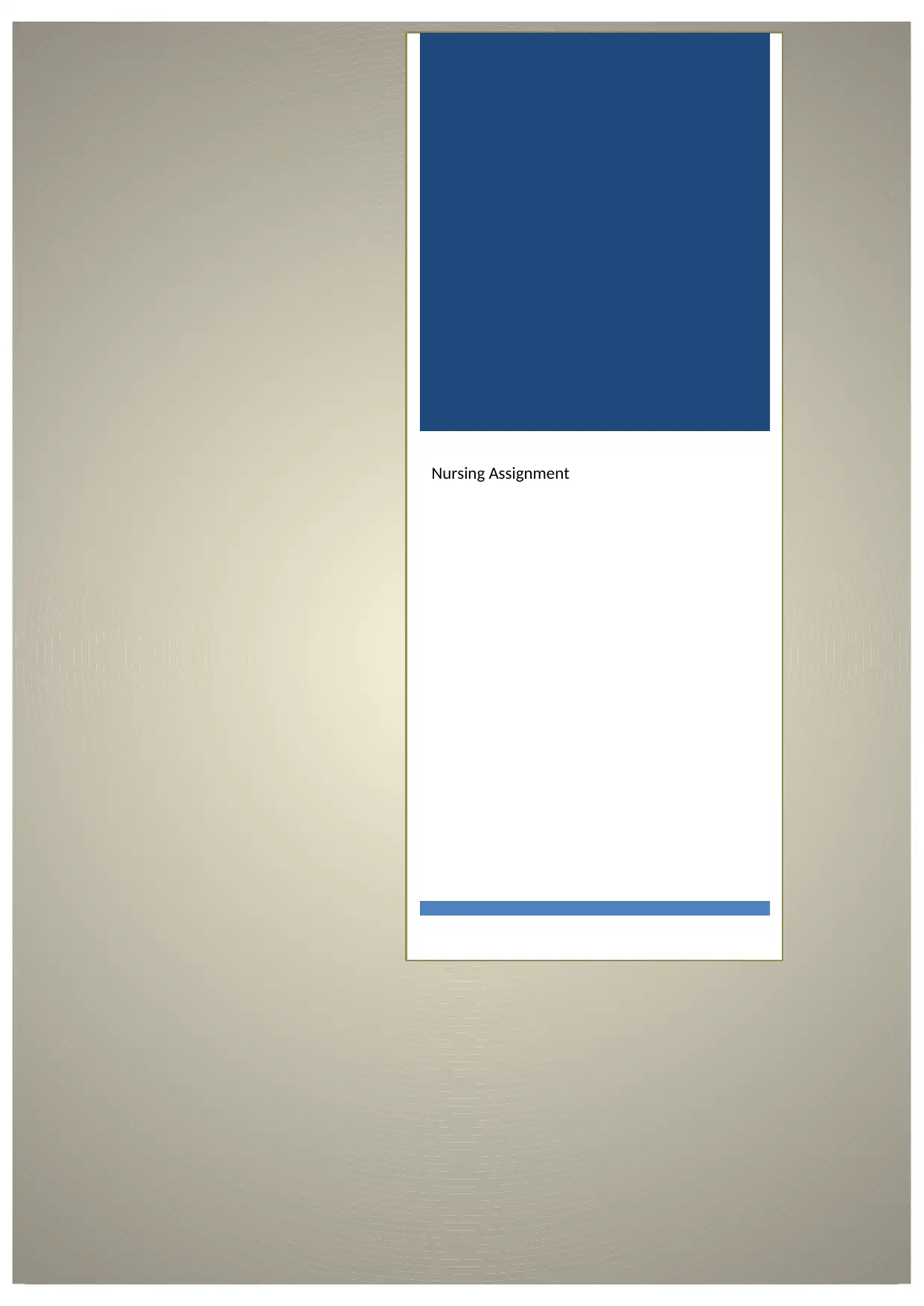
Nursing Assignment
Paraphrase This Document
Need a fresh take? Get an instant paraphrase of this document with our AI Paraphraser
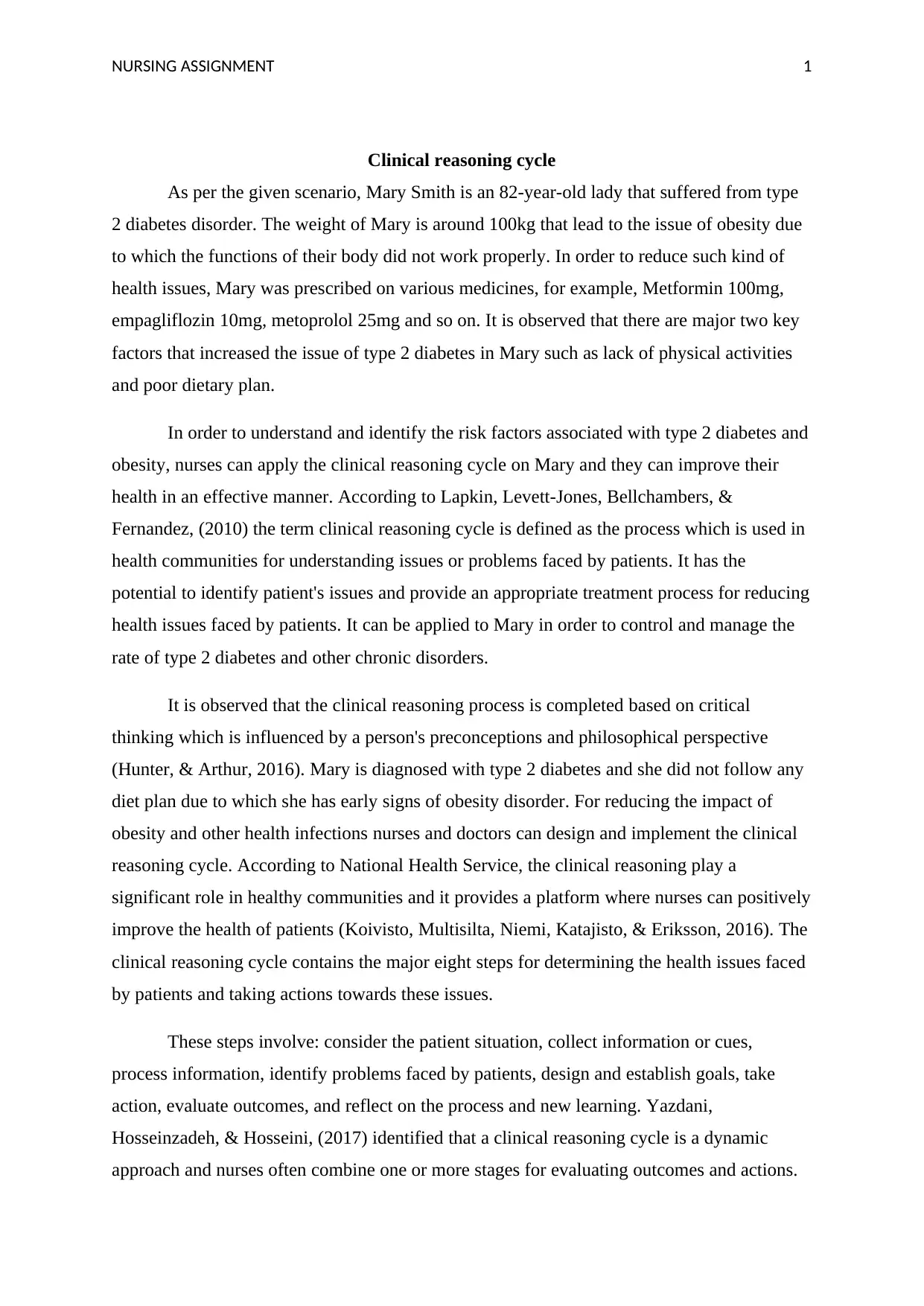
NURSING ASSIGNMENT 1
Clinical reasoning cycle
As per the given scenario, Mary Smith is an 82-year-old lady that suffered from type
2 diabetes disorder. The weight of Mary is around 100kg that lead to the issue of obesity due
to which the functions of their body did not work properly. In order to reduce such kind of
health issues, Mary was prescribed on various medicines, for example, Metformin 100mg,
empagliflozin 10mg, metoprolol 25mg and so on. It is observed that there are major two key
factors that increased the issue of type 2 diabetes in Mary such as lack of physical activities
and poor dietary plan.
In order to understand and identify the risk factors associated with type 2 diabetes and
obesity, nurses can apply the clinical reasoning cycle on Mary and they can improve their
health in an effective manner. According to Lapkin, Levett-Jones, Bellchambers, &
Fernandez, (2010) the term clinical reasoning cycle is defined as the process which is used in
health communities for understanding issues or problems faced by patients. It has the
potential to identify patient's issues and provide an appropriate treatment process for reducing
health issues faced by patients. It can be applied to Mary in order to control and manage the
rate of type 2 diabetes and other chronic disorders.
It is observed that the clinical reasoning process is completed based on critical
thinking which is influenced by a person's preconceptions and philosophical perspective
(Hunter, & Arthur, 2016). Mary is diagnosed with type 2 diabetes and she did not follow any
diet plan due to which she has early signs of obesity disorder. For reducing the impact of
obesity and other health infections nurses and doctors can design and implement the clinical
reasoning cycle. According to National Health Service, the clinical reasoning play a
significant role in healthy communities and it provides a platform where nurses can positively
improve the health of patients (Koivisto, Multisilta, Niemi, Katajisto, & Eriksson, 2016). The
clinical reasoning cycle contains the major eight steps for determining the health issues faced
by patients and taking actions towards these issues.
These steps involve: consider the patient situation, collect information or cues,
process information, identify problems faced by patients, design and establish goals, take
action, evaluate outcomes, and reflect on the process and new learning. Yazdani,
Hosseinzadeh, & Hosseini, (2017) identified that a clinical reasoning cycle is a dynamic
approach and nurses often combine one or more stages for evaluating outcomes and actions.
Clinical reasoning cycle
As per the given scenario, Mary Smith is an 82-year-old lady that suffered from type
2 diabetes disorder. The weight of Mary is around 100kg that lead to the issue of obesity due
to which the functions of their body did not work properly. In order to reduce such kind of
health issues, Mary was prescribed on various medicines, for example, Metformin 100mg,
empagliflozin 10mg, metoprolol 25mg and so on. It is observed that there are major two key
factors that increased the issue of type 2 diabetes in Mary such as lack of physical activities
and poor dietary plan.
In order to understand and identify the risk factors associated with type 2 diabetes and
obesity, nurses can apply the clinical reasoning cycle on Mary and they can improve their
health in an effective manner. According to Lapkin, Levett-Jones, Bellchambers, &
Fernandez, (2010) the term clinical reasoning cycle is defined as the process which is used in
health communities for understanding issues or problems faced by patients. It has the
potential to identify patient's issues and provide an appropriate treatment process for reducing
health issues faced by patients. It can be applied to Mary in order to control and manage the
rate of type 2 diabetes and other chronic disorders.
It is observed that the clinical reasoning process is completed based on critical
thinking which is influenced by a person's preconceptions and philosophical perspective
(Hunter, & Arthur, 2016). Mary is diagnosed with type 2 diabetes and she did not follow any
diet plan due to which she has early signs of obesity disorder. For reducing the impact of
obesity and other health infections nurses and doctors can design and implement the clinical
reasoning cycle. According to National Health Service, the clinical reasoning play a
significant role in healthy communities and it provides a platform where nurses can positively
improve the health of patients (Koivisto, Multisilta, Niemi, Katajisto, & Eriksson, 2016). The
clinical reasoning cycle contains the major eight steps for determining the health issues faced
by patients and taking actions towards these issues.
These steps involve: consider the patient situation, collect information or cues,
process information, identify problems faced by patients, design and establish goals, take
action, evaluate outcomes, and reflect on the process and new learning. Yazdani,
Hosseinzadeh, & Hosseini, (2017) identified that a clinical reasoning cycle is a dynamic
approach and nurses often combine one or more stages for evaluating outcomes and actions.
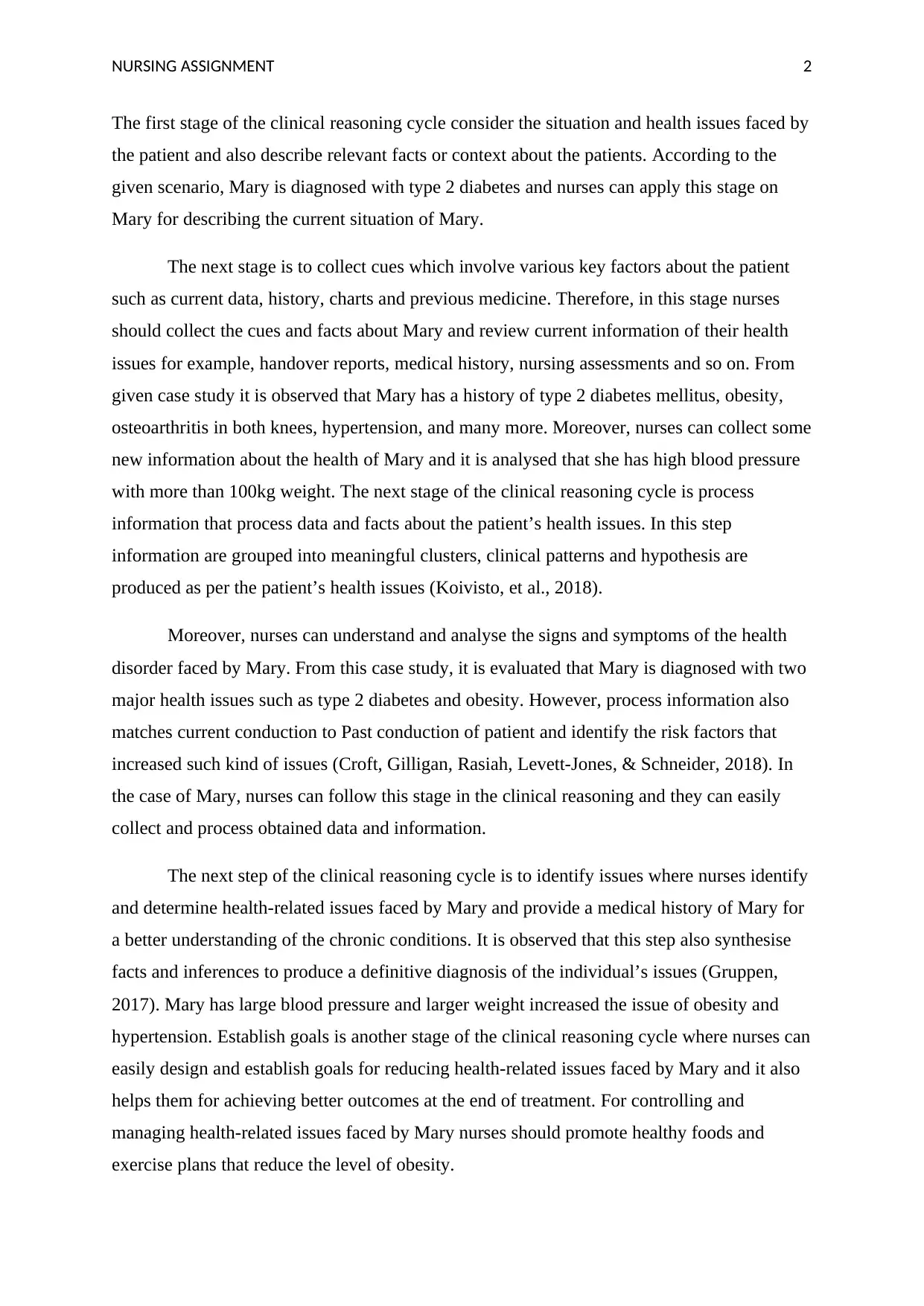
NURSING ASSIGNMENT 2
The first stage of the clinical reasoning cycle consider the situation and health issues faced by
the patient and also describe relevant facts or context about the patients. According to the
given scenario, Mary is diagnosed with type 2 diabetes and nurses can apply this stage on
Mary for describing the current situation of Mary.
The next stage is to collect cues which involve various key factors about the patient
such as current data, history, charts and previous medicine. Therefore, in this stage nurses
should collect the cues and facts about Mary and review current information of their health
issues for example, handover reports, medical history, nursing assessments and so on. From
given case study it is observed that Mary has a history of type 2 diabetes mellitus, obesity,
osteoarthritis in both knees, hypertension, and many more. Moreover, nurses can collect some
new information about the health of Mary and it is analysed that she has high blood pressure
with more than 100kg weight. The next stage of the clinical reasoning cycle is process
information that process data and facts about the patient’s health issues. In this step
information are grouped into meaningful clusters, clinical patterns and hypothesis are
produced as per the patient’s health issues (Koivisto, et al., 2018).
Moreover, nurses can understand and analyse the signs and symptoms of the health
disorder faced by Mary. From this case study, it is evaluated that Mary is diagnosed with two
major health issues such as type 2 diabetes and obesity. However, process information also
matches current conduction to Past conduction of patient and identify the risk factors that
increased such kind of issues (Croft, Gilligan, Rasiah, Levett-Jones, & Schneider, 2018). In
the case of Mary, nurses can follow this stage in the clinical reasoning and they can easily
collect and process obtained data and information.
The next step of the clinical reasoning cycle is to identify issues where nurses identify
and determine health-related issues faced by Mary and provide a medical history of Mary for
a better understanding of the chronic conditions. It is observed that this step also synthesise
facts and inferences to produce a definitive diagnosis of the individual’s issues (Gruppen,
2017). Mary has large blood pressure and larger weight increased the issue of obesity and
hypertension. Establish goals is another stage of the clinical reasoning cycle where nurses can
easily design and establish goals for reducing health-related issues faced by Mary and it also
helps them for achieving better outcomes at the end of treatment. For controlling and
managing health-related issues faced by Mary nurses should promote healthy foods and
exercise plans that reduce the level of obesity.
The first stage of the clinical reasoning cycle consider the situation and health issues faced by
the patient and also describe relevant facts or context about the patients. According to the
given scenario, Mary is diagnosed with type 2 diabetes and nurses can apply this stage on
Mary for describing the current situation of Mary.
The next stage is to collect cues which involve various key factors about the patient
such as current data, history, charts and previous medicine. Therefore, in this stage nurses
should collect the cues and facts about Mary and review current information of their health
issues for example, handover reports, medical history, nursing assessments and so on. From
given case study it is observed that Mary has a history of type 2 diabetes mellitus, obesity,
osteoarthritis in both knees, hypertension, and many more. Moreover, nurses can collect some
new information about the health of Mary and it is analysed that she has high blood pressure
with more than 100kg weight. The next stage of the clinical reasoning cycle is process
information that process data and facts about the patient’s health issues. In this step
information are grouped into meaningful clusters, clinical patterns and hypothesis are
produced as per the patient’s health issues (Koivisto, et al., 2018).
Moreover, nurses can understand and analyse the signs and symptoms of the health
disorder faced by Mary. From this case study, it is evaluated that Mary is diagnosed with two
major health issues such as type 2 diabetes and obesity. However, process information also
matches current conduction to Past conduction of patient and identify the risk factors that
increased such kind of issues (Croft, Gilligan, Rasiah, Levett-Jones, & Schneider, 2018). In
the case of Mary, nurses can follow this stage in the clinical reasoning and they can easily
collect and process obtained data and information.
The next step of the clinical reasoning cycle is to identify issues where nurses identify
and determine health-related issues faced by Mary and provide a medical history of Mary for
a better understanding of the chronic conditions. It is observed that this step also synthesise
facts and inferences to produce a definitive diagnosis of the individual’s issues (Gruppen,
2017). Mary has large blood pressure and larger weight increased the issue of obesity and
hypertension. Establish goals is another stage of the clinical reasoning cycle where nurses can
easily design and establish goals for reducing health-related issues faced by Mary and it also
helps them for achieving better outcomes at the end of treatment. For controlling and
managing health-related issues faced by Mary nurses should promote healthy foods and
exercise plans that reduce the level of obesity.
⊘ This is a preview!⊘
Do you want full access?
Subscribe today to unlock all pages.

Trusted by 1+ million students worldwide
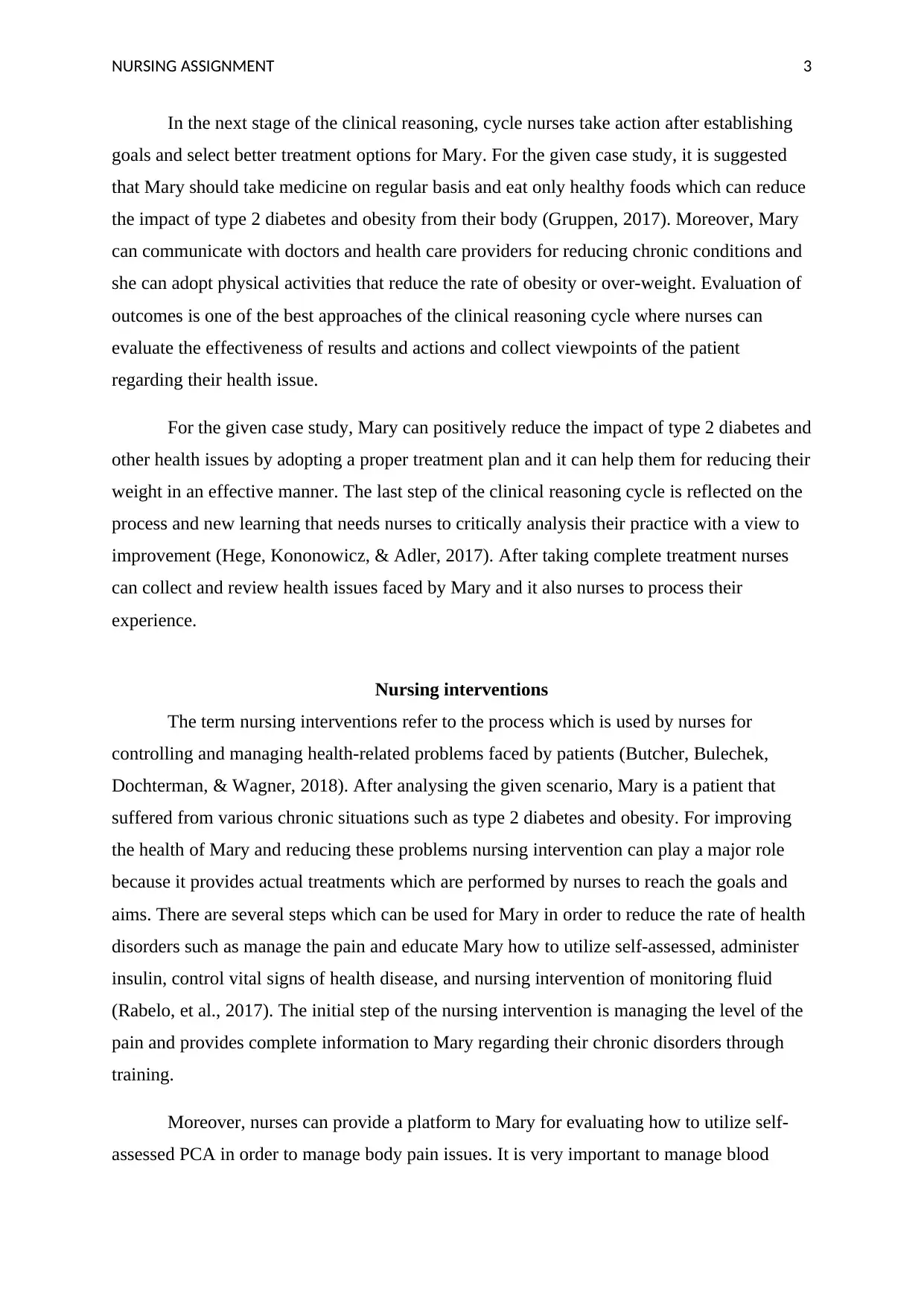
NURSING ASSIGNMENT 3
In the next stage of the clinical reasoning, cycle nurses take action after establishing
goals and select better treatment options for Mary. For the given case study, it is suggested
that Mary should take medicine on regular basis and eat only healthy foods which can reduce
the impact of type 2 diabetes and obesity from their body (Gruppen, 2017). Moreover, Mary
can communicate with doctors and health care providers for reducing chronic conditions and
she can adopt physical activities that reduce the rate of obesity or over-weight. Evaluation of
outcomes is one of the best approaches of the clinical reasoning cycle where nurses can
evaluate the effectiveness of results and actions and collect viewpoints of the patient
regarding their health issue.
For the given case study, Mary can positively reduce the impact of type 2 diabetes and
other health issues by adopting a proper treatment plan and it can help them for reducing their
weight in an effective manner. The last step of the clinical reasoning cycle is reflected on the
process and new learning that needs nurses to critically analysis their practice with a view to
improvement (Hege, Kononowicz, & Adler, 2017). After taking complete treatment nurses
can collect and review health issues faced by Mary and it also nurses to process their
experience.
Nursing interventions
The term nursing interventions refer to the process which is used by nurses for
controlling and managing health-related problems faced by patients (Butcher, Bulechek,
Dochterman, & Wagner, 2018). After analysing the given scenario, Mary is a patient that
suffered from various chronic situations such as type 2 diabetes and obesity. For improving
the health of Mary and reducing these problems nursing intervention can play a major role
because it provides actual treatments which are performed by nurses to reach the goals and
aims. There are several steps which can be used for Mary in order to reduce the rate of health
disorders such as manage the pain and educate Mary how to utilize self-assessed, administer
insulin, control vital signs of health disease, and nursing intervention of monitoring fluid
(Rabelo, et al., 2017). The initial step of the nursing intervention is managing the level of the
pain and provides complete information to Mary regarding their chronic disorders through
training.
Moreover, nurses can provide a platform to Mary for evaluating how to utilize self-
assessed PCA in order to manage body pain issues. It is very important to manage blood
In the next stage of the clinical reasoning, cycle nurses take action after establishing
goals and select better treatment options for Mary. For the given case study, it is suggested
that Mary should take medicine on regular basis and eat only healthy foods which can reduce
the impact of type 2 diabetes and obesity from their body (Gruppen, 2017). Moreover, Mary
can communicate with doctors and health care providers for reducing chronic conditions and
she can adopt physical activities that reduce the rate of obesity or over-weight. Evaluation of
outcomes is one of the best approaches of the clinical reasoning cycle where nurses can
evaluate the effectiveness of results and actions and collect viewpoints of the patient
regarding their health issue.
For the given case study, Mary can positively reduce the impact of type 2 diabetes and
other health issues by adopting a proper treatment plan and it can help them for reducing their
weight in an effective manner. The last step of the clinical reasoning cycle is reflected on the
process and new learning that needs nurses to critically analysis their practice with a view to
improvement (Hege, Kononowicz, & Adler, 2017). After taking complete treatment nurses
can collect and review health issues faced by Mary and it also nurses to process their
experience.
Nursing interventions
The term nursing interventions refer to the process which is used by nurses for
controlling and managing health-related problems faced by patients (Butcher, Bulechek,
Dochterman, & Wagner, 2018). After analysing the given scenario, Mary is a patient that
suffered from various chronic situations such as type 2 diabetes and obesity. For improving
the health of Mary and reducing these problems nursing intervention can play a major role
because it provides actual treatments which are performed by nurses to reach the goals and
aims. There are several steps which can be used for Mary in order to reduce the rate of health
disorders such as manage the pain and educate Mary how to utilize self-assessed, administer
insulin, control vital signs of health disease, and nursing intervention of monitoring fluid
(Rabelo, et al., 2017). The initial step of the nursing intervention is managing the level of the
pain and provides complete information to Mary regarding their chronic disorders through
training.
Moreover, nurses can provide a platform to Mary for evaluating how to utilize self-
assessed PCA in order to manage body pain issues. It is very important to manage blood
Paraphrase This Document
Need a fresh take? Get an instant paraphrase of this document with our AI Paraphraser
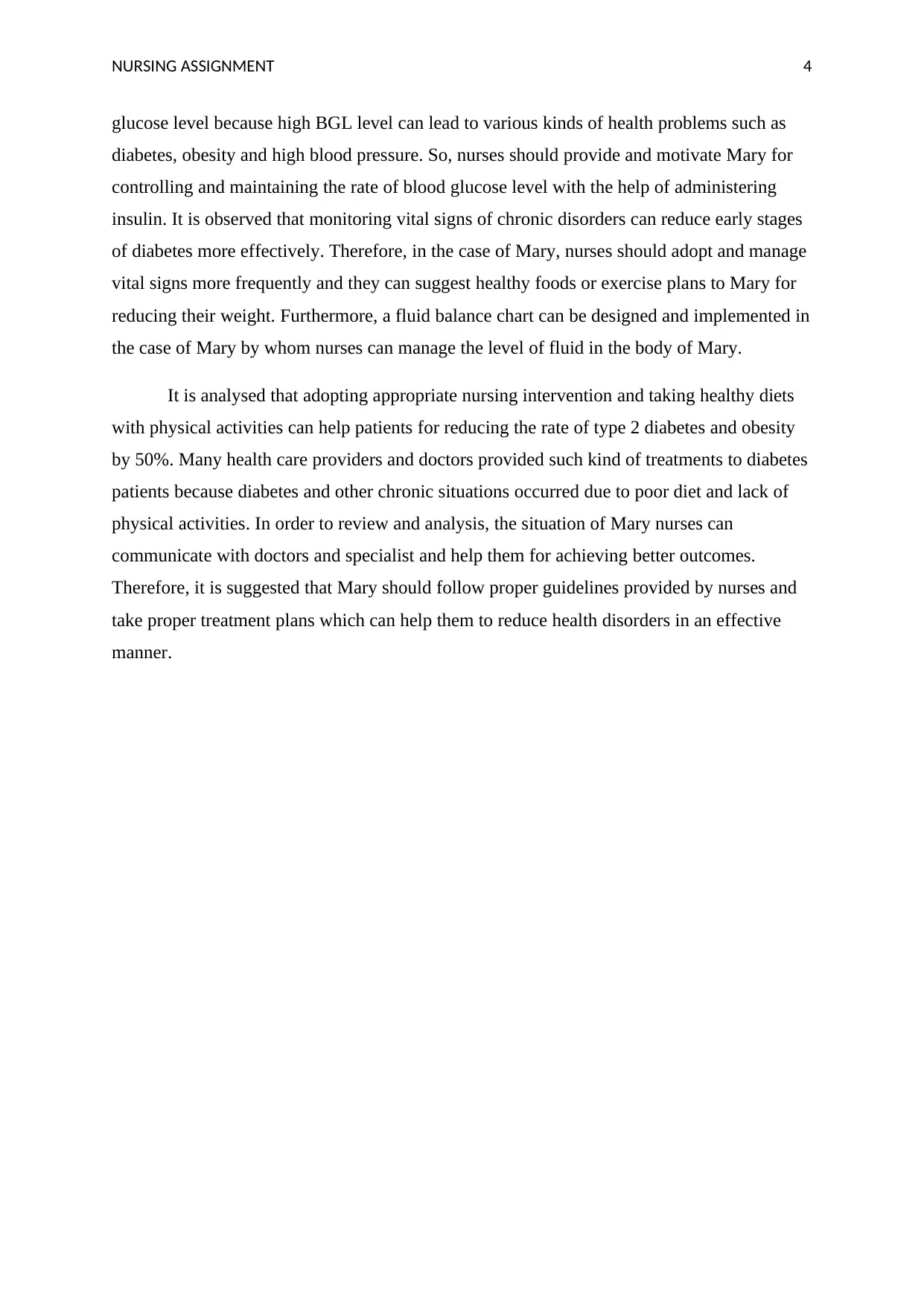
NURSING ASSIGNMENT 4
glucose level because high BGL level can lead to various kinds of health problems such as
diabetes, obesity and high blood pressure. So, nurses should provide and motivate Mary for
controlling and maintaining the rate of blood glucose level with the help of administering
insulin. It is observed that monitoring vital signs of chronic disorders can reduce early stages
of diabetes more effectively. Therefore, in the case of Mary, nurses should adopt and manage
vital signs more frequently and they can suggest healthy foods or exercise plans to Mary for
reducing their weight. Furthermore, a fluid balance chart can be designed and implemented in
the case of Mary by whom nurses can manage the level of fluid in the body of Mary.
It is analysed that adopting appropriate nursing intervention and taking healthy diets
with physical activities can help patients for reducing the rate of type 2 diabetes and obesity
by 50%. Many health care providers and doctors provided such kind of treatments to diabetes
patients because diabetes and other chronic situations occurred due to poor diet and lack of
physical activities. In order to review and analysis, the situation of Mary nurses can
communicate with doctors and specialist and help them for achieving better outcomes.
Therefore, it is suggested that Mary should follow proper guidelines provided by nurses and
take proper treatment plans which can help them to reduce health disorders in an effective
manner.
glucose level because high BGL level can lead to various kinds of health problems such as
diabetes, obesity and high blood pressure. So, nurses should provide and motivate Mary for
controlling and maintaining the rate of blood glucose level with the help of administering
insulin. It is observed that monitoring vital signs of chronic disorders can reduce early stages
of diabetes more effectively. Therefore, in the case of Mary, nurses should adopt and manage
vital signs more frequently and they can suggest healthy foods or exercise plans to Mary for
reducing their weight. Furthermore, a fluid balance chart can be designed and implemented in
the case of Mary by whom nurses can manage the level of fluid in the body of Mary.
It is analysed that adopting appropriate nursing intervention and taking healthy diets
with physical activities can help patients for reducing the rate of type 2 diabetes and obesity
by 50%. Many health care providers and doctors provided such kind of treatments to diabetes
patients because diabetes and other chronic situations occurred due to poor diet and lack of
physical activities. In order to review and analysis, the situation of Mary nurses can
communicate with doctors and specialist and help them for achieving better outcomes.
Therefore, it is suggested that Mary should follow proper guidelines provided by nurses and
take proper treatment plans which can help them to reduce health disorders in an effective
manner.
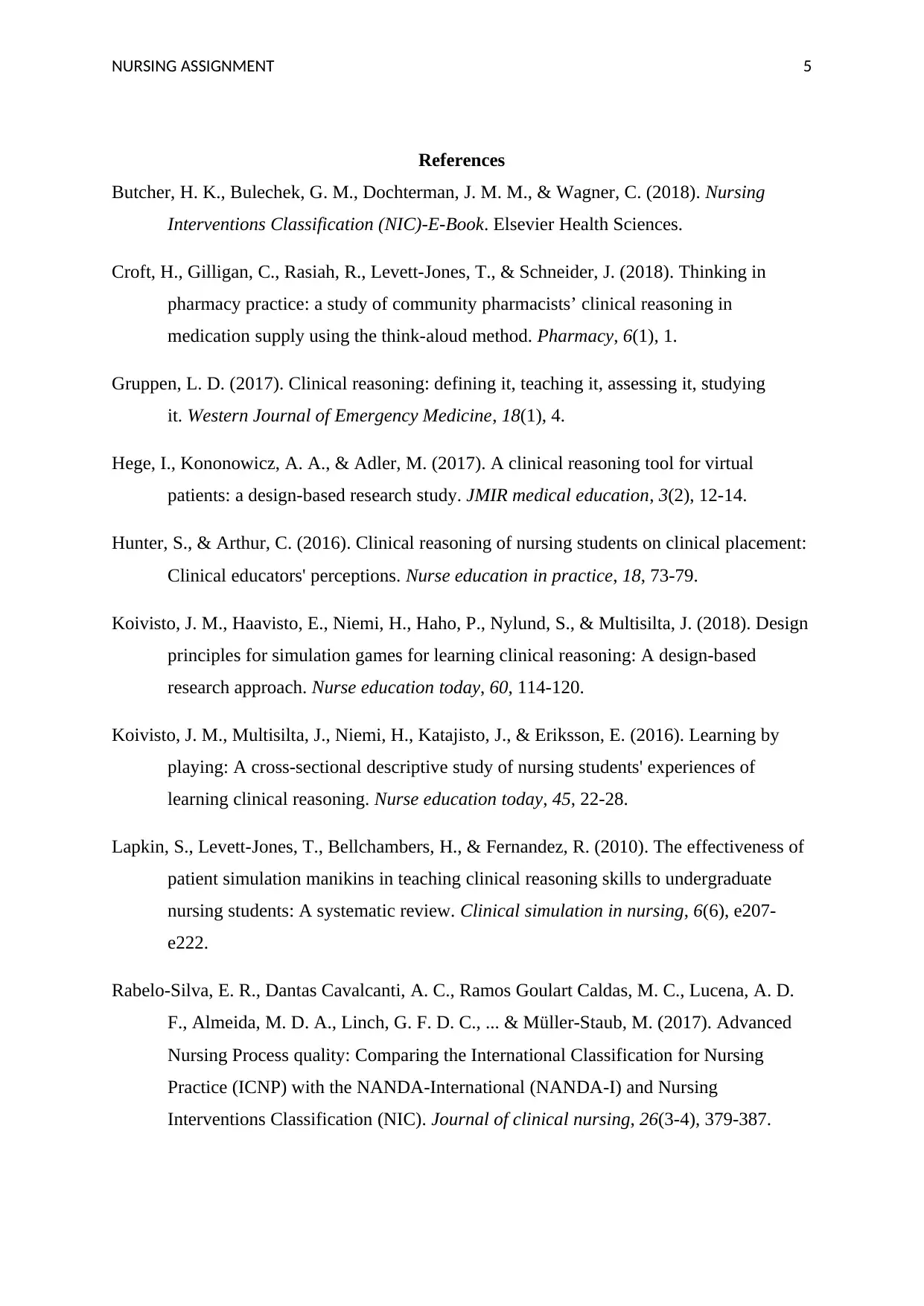
NURSING ASSIGNMENT 5
References
Butcher, H. K., Bulechek, G. M., Dochterman, J. M. M., & Wagner, C. (2018). Nursing
Interventions Classification (NIC)-E-Book. Elsevier Health Sciences.
Croft, H., Gilligan, C., Rasiah, R., Levett-Jones, T., & Schneider, J. (2018). Thinking in
pharmacy practice: a study of community pharmacists’ clinical reasoning in
medication supply using the think-aloud method. Pharmacy, 6(1), 1.
Gruppen, L. D. (2017). Clinical reasoning: defining it, teaching it, assessing it, studying
it. Western Journal of Emergency Medicine, 18(1), 4.
Hege, I., Kononowicz, A. A., & Adler, M. (2017). A clinical reasoning tool for virtual
patients: a design-based research study. JMIR medical education, 3(2), 12-14.
Hunter, S., & Arthur, C. (2016). Clinical reasoning of nursing students on clinical placement:
Clinical educators' perceptions. Nurse education in practice, 18, 73-79.
Koivisto, J. M., Haavisto, E., Niemi, H., Haho, P., Nylund, S., & Multisilta, J. (2018). Design
principles for simulation games for learning clinical reasoning: A design-based
research approach. Nurse education today, 60, 114-120.
Koivisto, J. M., Multisilta, J., Niemi, H., Katajisto, J., & Eriksson, E. (2016). Learning by
playing: A cross-sectional descriptive study of nursing students' experiences of
learning clinical reasoning. Nurse education today, 45, 22-28.
Lapkin, S., Levett-Jones, T., Bellchambers, H., & Fernandez, R. (2010). The effectiveness of
patient simulation manikins in teaching clinical reasoning skills to undergraduate
nursing students: A systematic review. Clinical simulation in nursing, 6(6), e207-
e222.
Rabelo‐Silva, E. R., Dantas Cavalcanti, A. C., Ramos Goulart Caldas, M. C., Lucena, A. D.
F., Almeida, M. D. A., Linch, G. F. D. C., ... & Müller‐Staub, M. (2017). Advanced
Nursing Process quality: Comparing the International Classification for Nursing
Practice (ICNP) with the NANDA‐International (NANDA‐I) and Nursing
Interventions Classification (NIC). Journal of clinical nursing, 26(3-4), 379-387.
References
Butcher, H. K., Bulechek, G. M., Dochterman, J. M. M., & Wagner, C. (2018). Nursing
Interventions Classification (NIC)-E-Book. Elsevier Health Sciences.
Croft, H., Gilligan, C., Rasiah, R., Levett-Jones, T., & Schneider, J. (2018). Thinking in
pharmacy practice: a study of community pharmacists’ clinical reasoning in
medication supply using the think-aloud method. Pharmacy, 6(1), 1.
Gruppen, L. D. (2017). Clinical reasoning: defining it, teaching it, assessing it, studying
it. Western Journal of Emergency Medicine, 18(1), 4.
Hege, I., Kononowicz, A. A., & Adler, M. (2017). A clinical reasoning tool for virtual
patients: a design-based research study. JMIR medical education, 3(2), 12-14.
Hunter, S., & Arthur, C. (2016). Clinical reasoning of nursing students on clinical placement:
Clinical educators' perceptions. Nurse education in practice, 18, 73-79.
Koivisto, J. M., Haavisto, E., Niemi, H., Haho, P., Nylund, S., & Multisilta, J. (2018). Design
principles for simulation games for learning clinical reasoning: A design-based
research approach. Nurse education today, 60, 114-120.
Koivisto, J. M., Multisilta, J., Niemi, H., Katajisto, J., & Eriksson, E. (2016). Learning by
playing: A cross-sectional descriptive study of nursing students' experiences of
learning clinical reasoning. Nurse education today, 45, 22-28.
Lapkin, S., Levett-Jones, T., Bellchambers, H., & Fernandez, R. (2010). The effectiveness of
patient simulation manikins in teaching clinical reasoning skills to undergraduate
nursing students: A systematic review. Clinical simulation in nursing, 6(6), e207-
e222.
Rabelo‐Silva, E. R., Dantas Cavalcanti, A. C., Ramos Goulart Caldas, M. C., Lucena, A. D.
F., Almeida, M. D. A., Linch, G. F. D. C., ... & Müller‐Staub, M. (2017). Advanced
Nursing Process quality: Comparing the International Classification for Nursing
Practice (ICNP) with the NANDA‐International (NANDA‐I) and Nursing
Interventions Classification (NIC). Journal of clinical nursing, 26(3-4), 379-387.
⊘ This is a preview!⊘
Do you want full access?
Subscribe today to unlock all pages.

Trusted by 1+ million students worldwide
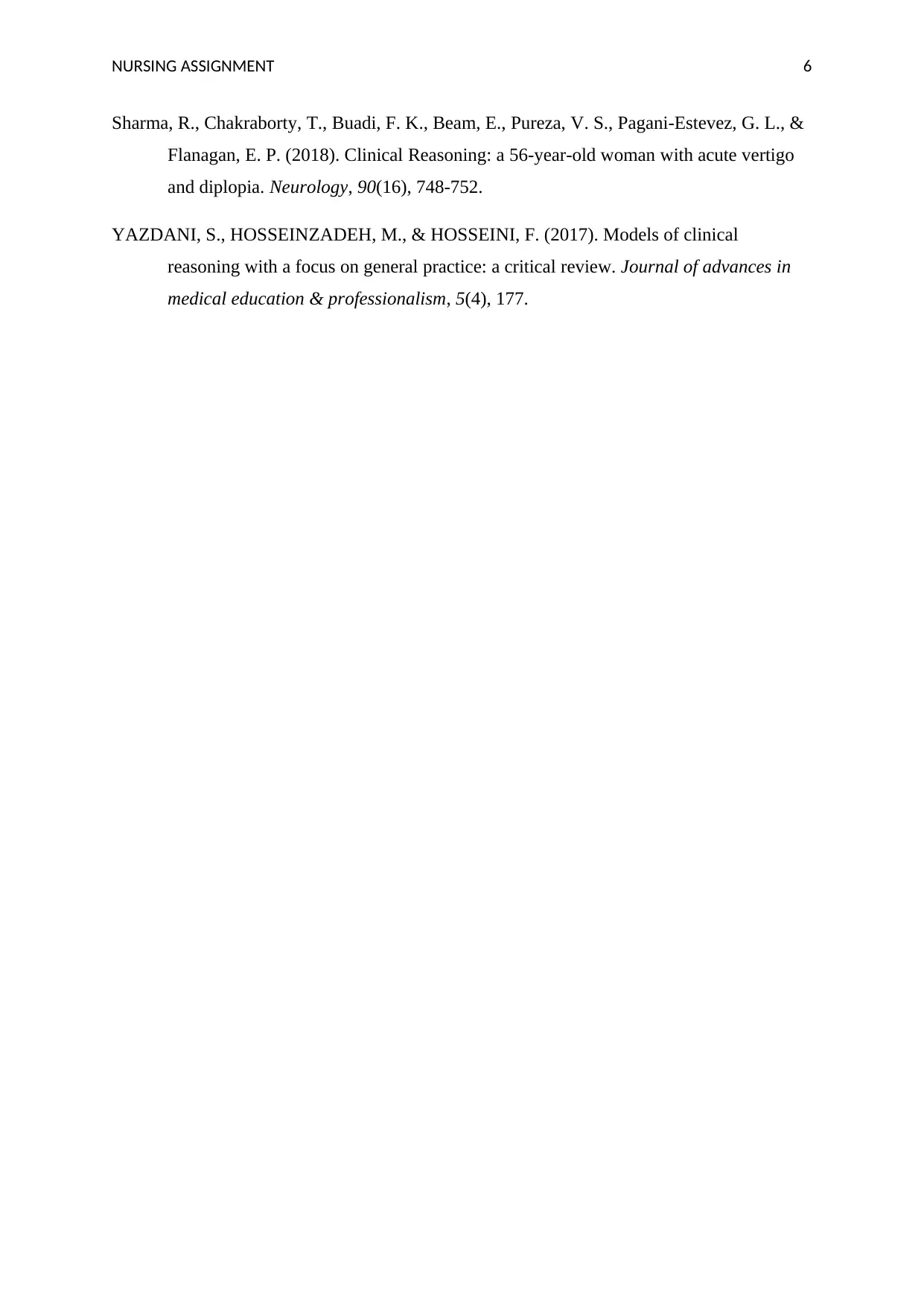
NURSING ASSIGNMENT 6
Sharma, R., Chakraborty, T., Buadi, F. K., Beam, E., Pureza, V. S., Pagani-Estevez, G. L., &
Flanagan, E. P. (2018). Clinical Reasoning: a 56-year-old woman with acute vertigo
and diplopia. Neurology, 90(16), 748-752.
YAZDANI, S., HOSSEINZADEH, M., & HOSSEINI, F. (2017). Models of clinical
reasoning with a focus on general practice: a critical review. Journal of advances in
medical education & professionalism, 5(4), 177.
Sharma, R., Chakraborty, T., Buadi, F. K., Beam, E., Pureza, V. S., Pagani-Estevez, G. L., &
Flanagan, E. P. (2018). Clinical Reasoning: a 56-year-old woman with acute vertigo
and diplopia. Neurology, 90(16), 748-752.
YAZDANI, S., HOSSEINZADEH, M., & HOSSEINI, F. (2017). Models of clinical
reasoning with a focus on general practice: a critical review. Journal of advances in
medical education & professionalism, 5(4), 177.
1 out of 7
Related Documents
Your All-in-One AI-Powered Toolkit for Academic Success.
+13062052269
info@desklib.com
Available 24*7 on WhatsApp / Email
![[object Object]](/_next/static/media/star-bottom.7253800d.svg)
Unlock your academic potential
Copyright © 2020–2025 A2Z Services. All Rights Reserved. Developed and managed by ZUCOL.





